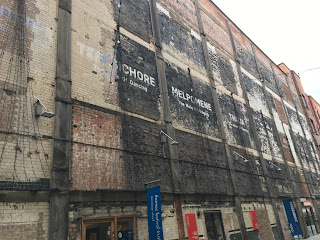Observation of Art
I’ve lived
in London for almost six years now, and I’ve been to the Tate Modern more times
in the past three months than I have done the whole time I’ve been in this
wonderful city!
Exploring on the way to Tate Modern
Participant
Observation refers to both an etic observation of others participation, but
also an emic perspective gained by participation in an activity yourself. So, I
took myself around the Tate Modern on a gloomy afternoon, and
observed-as-participant, those who were participating in an artistic, cultural
experience.
Bubbles outside Tate Modern
We were
encouraged to look at the layout of the building and discover how people used
the space: from a practical point of view, the Tate Modern is laid out well,
clearly signposted and marked, and provides equal access without restricting or
delimited which route visitors are required to take. Galleries also reflect
this, encouraging the creation of ‘desire lines’ around, above, and behind the
artworks on display. I was also struck by the sensation when entering the
gallery; the entrances are quite covered, and almost tunnel-like, but suddenly
open out onto the huge space of the Turbine Hall – this creates the sense of
cresting a hill, looking down into a valley; a playful sense of discovery and
adventure.
However, the
lack of windows, the comparatively small, and out of the way, entrances could
be considered a barrier to access; if you don’t *know* the way *in*, literally
and metaphorically. I feel this could be mitigated somewhat (because the
architecture itself can’t really be changed!) by taking advantage of the
copious space outside the gallery, and creating installations which lead, physically
and psychically, into the gallery – this thought occurred to me as I sat in a
window bay, and watched passers-by look out of the window to the swing set in a
courtyard; they were so excited by them, many raced off to find how to get
there!
Methods of participation: playing in the Turbine Hall; walking past and glancing; reading the information sheets; studying from afar; photographing; getting involved in immersive work.
There is a
strange sense of liminality in the gallery; the lack of clocks, the ambient
light, and the soft susurrus of bodies moving all combine to create a time out
of time, and a space within space. There is no sensation of time passing, like
we are being held in a limbo, which is comforting yet unsettling. I wonder how
an experiment with different qualities of light would affect the visiting
experience? I am also intrigued by the quiet, traditional to galleries, but
maybe out of place in a gallery which is, by its very nomenclature, modern – it
would be interesting to see whether music, whether in a specific installation,
or in different usages throughout the space, would impact on a visitor experience.
As I sat in
my window bay, writing unconsciously, as we practised a few weeks ago, and doodling a map of my movements around the
gallery, I watched other people interacting with the art, the way they moved –
purposefully, to find the thing they had come to see; purposeless – allowing their
gaze to be drawn to one thing then another, and following instinct; or panicked
– parents chasing errant children! We write our own stories when we visit a
space like the Tate Modern, and are permitted to join in the sense of adventure
and exploration.












Comments
Post a Comment